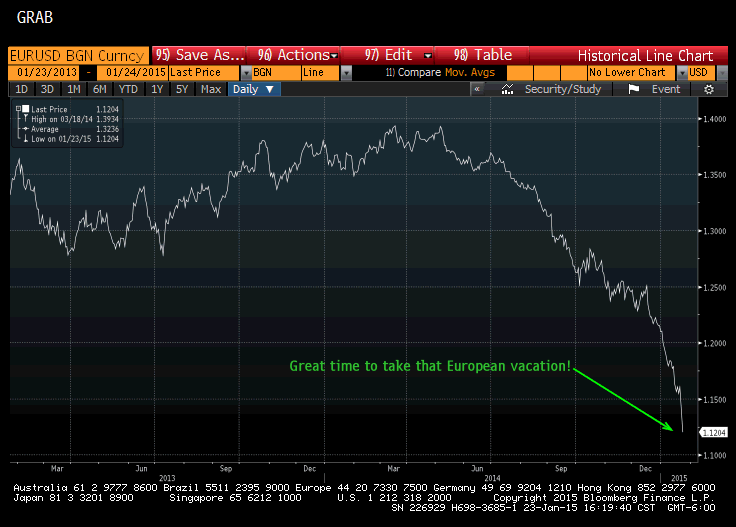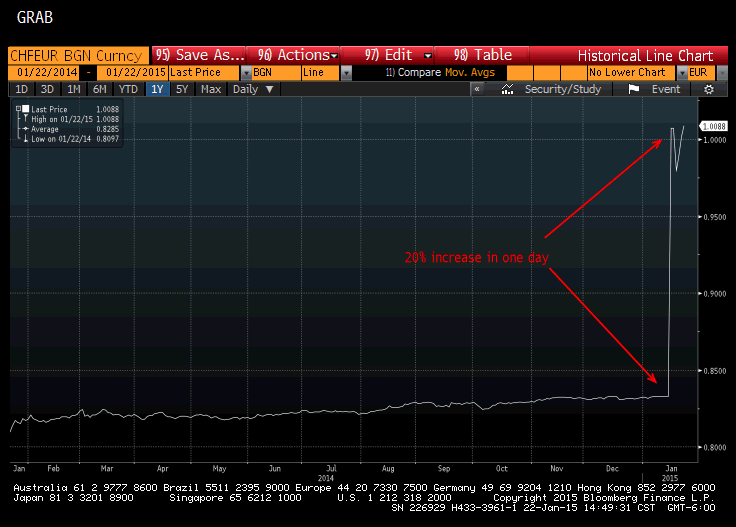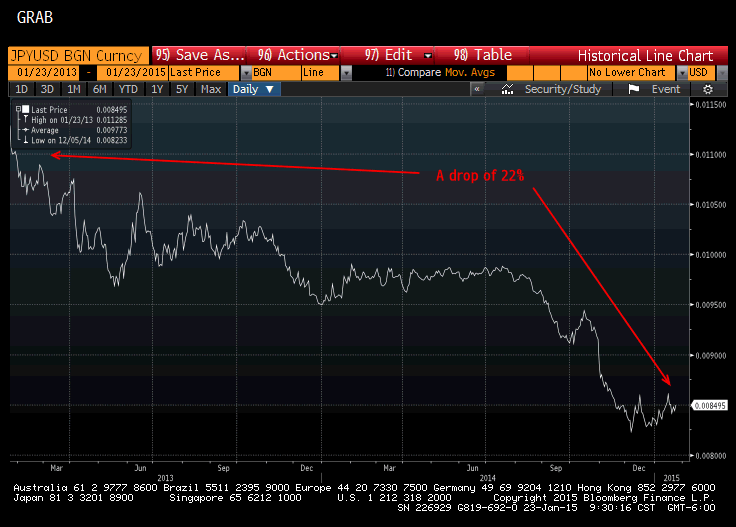Last year proved to be another good year for the U.S. economy, as well as the U.S. stock market, while wreaking havoc on foreign economies and foreign stock markets.
The S&P 500 increased 13.66% while the All World (ex U.S.) Index declined 3.87%.
A 50%+ decline in the price of oil blistered countries (and companies) whose fortunes are closely tied to the price of oil. In early 2014, oil traded as high as $107 per barrel. It ended the year just above $53, and is now trading below $50.
Countries like Russia, that depend heavily on the price of oil are suffering, leading conspiracy theorists to believe that the price drop was engineered in retaliation for Russia invading Ukraine. The more likely explanation is that increases in oil production throughout the world, combined with a global economic slowdown, resulted in an imbalance in the supply/demand of oil. Conspiracy theorists confer way too much credit to the intelligence of those in charge.
A more credible conspiracy theory (if you must have one) is that the Saudis would like to drive higher cost producers out of business. Flooding the market with oil to drive down the price is making life difficult for oil drillers whose cost per barrel is much higher than the Saudis.
Global economic activity will not be accelerating any time soon, so don’t expect a quick snapback in the price of oil. And it’s not just oil. Commodities in general are “rolling over.” Steel and copper are hitting new lows along with oil. Too much capacity, not enough demand.
As an American consumer, you can continue to enjoy low prices at the pump that haven’t been seen in a long, long time. These low prices are resulting in a windfall of discretionary spending cash for the low-end wage earner. Gasoline, as a percentage of overall expenses, is a significant portion of their income and should directly result in increased low-end consumer spending. Discount retailers should benefit directly from this.
Almost three million new jobs were created in the U.S. last year, the most since 1999. Unemployment fell to another post-recession low. 252,000 new jobs were added in December, reducing the unemployment rate to 5.6%.
Interestingly, this relatively low level of unemployment has not yet resulted in meaningful wage gains. Wage increases in 2014 were close to the rate of inflation, resulting in virtually no increase in the standard of living for the average wage earner.
No wage gains combined with declining economic activity overseas and the drop in energy prices means inflation remains almost non-existent and interest rates remain low, low, low. The 30-year Treasury bond broke the 3% barrier, and is now trading below 2.4%. The 10-year Treasury bond is trading below 1.9%.
Gross Domestic Product (GDP) has rebounded nicely, and we expect GDP growth to be around 3% in 2015. However, growth in Europe continues to be rather stagnant. And the euro has suffered for the past six months because of it. In the 2-year graph below, you can see the value of the euro relative to the U.S. dollar. In the past six months, it has declined approximately 18%. And in light of the European Central Bank’s (ECB) announcement to increase their own Quantitative Easing (QE) by buying billions of bonds in the open market, the euro has declined even more.

The Swiss, whose own Swiss franc (CHF) has been pegged to the value of the euro for several years, decided last week to “un-peg” the Swiss franc from the euro. That means the Swiss franc began trading on its own relative to other currencies. The Swiss figured they weren’t running their economy into the ground, so why should the financially irresponsible countries of the Eurozone drag down the franc.
Below is a 2-year graph of the Swiss franc vs. the euro.

When the CHF became “uncoupled” from the euro, it shot up in value 20% in one day.
But it’s not just the Eurozone. Many other countries are experiencing a continued economic malaise. Below is a 2-year graph of the Japanese yen vs. the U.S. dollar.

It has declined 22% over the past two years, half of the decline occurring in the past six months.
If this sounds really positive to you, well it isn’t. I mean it’s positive in that our country is doing much better economically than a lot of other nations. It’s a positive in that products made in these foreign countries are now cheaper for us to purchase. But it’s also a negative because it means our exports will suffer because our products are now more expensive for foreign consumers. Companies that sell their products in the Eurozone will see their earnings decline because of this sharp decline in the euro.
The irony in all of this is the investor concern several years ago about the value of the U.S. dollar. There was no lack of Chicken Littles out there warning us that the sky was falling, and that we needed to buy gold. It turns out the U.S. dollar is one of the few currencies NOT getting crushed. I pointed out in several previous Investment Commentaries that the value of the dollar is a RELATIVE issue. The dollar is always valued RELATIVE to other currencies. All we had to do was rely on other countries to execute more poorly than the U.S. and the dollar remains the global currency of choice. That is not going to change any time soon.
With a strong dollar, low interest rates and virtually no sign of inflation, we see little need to own gold or other types of hedges against financial disaster.
Chris Harrington, our senior portfolio manager pointed out to me that India might pose an interesting growth story someday (he didn’t even try to predict when). He noted that India and China have virtually the same population, give or take a few million. But China, which has been a tremendous growth story for the past 10+ years, dwarfs India in economic activity. In 2013, China bought 22 million units in auto sales. India managed a meager 2.5 million units. China consumed 740 million tons of steel, while India consumed 80 million tons.
A little more digging and we discovered that China has 642 million Internet users compared to India’s 243 million. The U.S. has 280 million users and ¼ the population of India. What are the Indian people doing, and what do the numbers say about their potential in the future?
In the history of the Olympics, the U.S. holds 2684 total medals. China has 526. (China has only really gotten into the Olympic spirit of things in the past few decades.) Sweden, with only 10 million people, has 627 medals. Granted, most of them are in winter sports, but there are more people in New York City than in Sweden. India, with 1.3 billion people has a measly 26 medals. TWENTY-SIX MEDALS! EVER! IN THE HISTORY OF THE OLYMPICS! Come on, man. Are they even trying?
With any kind of good economic leadership, India could become an interesting investment story someday. There is a tremendous amount of untapped potential.
At Boyer & Corporon Wealth Management, we have shortened our duration somewhat in the past few months, but still have a significant allocation to long duration zero coupon bonds. Particularly municipal bonds in the state of California. They have been our best investment for the past four years, but we have been taking advantage of the recent drop in interest rates to reduce our allocation. Although we own some multi-national stocks (which are not doing well because of the strong dollar), we are avoiding investing additional funds in multi-nationals for a while. We have a larger cash position than we have had in years, and we are in no hurry to reduce it.
This information is provided for general information purposes only and should not be construed as investment, tax, or legal advice. Past performance of any market results is no assurance of future performance. The information contained herein has been obtained from sources deemed reliable but is not guaranteed.
